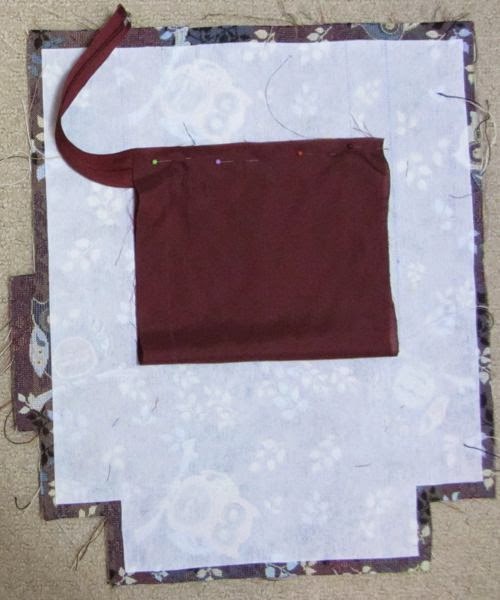The zipper is sewn into a window in the side of the bag, somewhat like (some ways of making) a welt pocket or bound buttonhole, but since the strap will cover the ends, those do not need to be neatly turned under. To avoid bulk there I just cut vertical slashes.
The zipper is overly long because it was the only way I could get one that would match the top zipper as well as meeting other criteria: the color looks reasonable with this fabric, the coil is fairly wide, and the pull is decorative and will hang down vertically, even with the zipper placed horizontally.
First one edge of the pocket bag is held onto the lower zipper tape by a double row of topstitching. The wrong side — if there is one — of the pocket bag fabric is up. I tacked it on with whipstitching beforehand, since this was sewn through from the right side where I couldn't keep an eye on it. There is no need to remove the basting, if it doesn't go through to the outside.
I suspect this was done with a twin needle in the original, but I'd have no way to be sure without taking it apart. I did two rows with the single needle, which are not as perfect but will have to do. The thread is Gütermann Mara 30; this is a bit beyond the weight my machine will readily sew, and even if I'd had a large enough double needle, my machine doesn't do all that well with those either.
Then I flipped the pocket bag down. I gave it a quick hand understitch too, to really make sure it doesn't ride up into the zipper pull, though this shouldn't be strictly necessary.
Then the other end of the pocket bag is folded up to meet the top edge of the zipper tape, and the topstitching will be repeated there. Again, I will hand baste it first to avoid any nasty surprises. Finally, the attachment of the straps will catch the sides of the pocket bag.
By the way, this pocket bag is cut all in one piece, with the bottom being a fold. It saves some work, if your cutting layout will allow it.
The fact that the pocket bag can be constructed and attached entirely by the topstitching led me to realize how the handles of the original could have been attached and topstitched in one pass, without the stitching being visible on the inside of the bag.
It turns out the lining was not bagged out at all, in the sense of being sewn on with a hole left for turning. So my proposed construction order was not correct. Instead, the handles must have been attached/topstitched with the top edges of the bag sides already turned under, at least where the handles crossed them. The lining and shell were each assembled completely, their top edges turned under, the lining put into the bag, some parts of the bottom seam allowances were sewn together from the inside so that the lining can't be pulled out, and then finally the turned-under top edges were lined up perfectly and edgestitched together. (I can confirm that the topstitching is all that's holding those top edges together, because I can run my fingernail between them.)
I will try to do the same, because it will be much easier than wrestling a bagged lining around my stiffly interfaced fabric. I will probably add a hand-basting step to make things easier for myself.
On the pocket-less side, I got as far as attaching the handles with edgestitching. I will do the same on the pocket side before deciding what further topstitching to do, but I think it will follow the pattern rather than involving a big X shape as on the original.


































